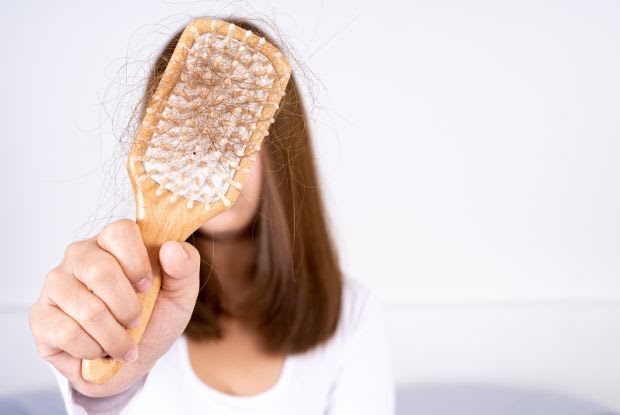The Hair Growth Cycle Explained: What’s Normal and What’s Not
The Hair Growth Cycle Explained: What’s Normal and What’s Not
Table of Contents
I. What Is the Hair Growth Cycle?
II. How Much Hair Loss Is Normal?
III. When Hair Loss Becomes a Concern
IV. What Affects Your Hair Growth Cycle?
Understanding the hair growth cycle can give you valuable insights into what’s normal, what’s not, and how to keep your hair healthy. From routine shedding to the early signs of a receding hairline, knowing what’s happening beneath the surface can make all the difference.
In this article, we'll explore the phases of the hair growth cycle so you can get acquainted with what's normal. That way, you'll be able to identify changes and work with your doctor to get your hair back on track if needed.
What Is the Hair Growth Cycle?
The hair growth cycle is the natural process your hair goes through to grow, rest, and shed. Each hair follicle goes through the cycle independently, so you don’t lose all your hair at once. 1
The hair growth cycle has three stages:
Anagen Phase (Growth)
- This is the active growth phase of the hair follicle, where your hair becomes longer and thicker. The anagen phase can last anywhere from two to eight years, depending on genetics, age, and overall health.
- The length of this phase largely determines how long your hair can grow. 1
Catagen Phase (Transition)
- The catagen phase is a brief transitional stage lasting about two weeks. During this phase, hair growth stops, and the follicle shrinks as it prepares to enter the resting stage.
- Only about 1% of your hair is in the catagen phase at any given time. While this phase is relatively short, it plays an important role in resetting the follicle for new growth. 1
Telogen Phase (Rest)
- In the telogen phase, hair enters a resting period that typically lasts two to three months. During this time, the hair remains in the follicle before eventually shedding.
- Around 100 to 150 hair strands are in the telogen phase at any given time. Shedding during this phase is entirely natural and part of the cycle. 1
How Much Hair Loss Is Normal?

Shedding between 100 to 150 hairs per day is a natural part of the hair growth cycle and should not be a cause for concern. 1 However, there are specific scenarios where changes in your body can temporarily alter the cycle:
- Pregnancy: During pregnancy, hormonal shifts extend the anagen phase, resulting in fuller and thicker hair. After childbirth, many women experience increased shedding as their hair transitions back to its regular cycle.
- Seasonal changes: Some people notice more shedding in specific seasons.
- Age-related changes: As you age, the anagen phase shortens, leading to slower hair growth and potential thinning. 2
Recognizing these patterns can help differentiate between normal hair shedding vs hair loss.
When Hair Loss Becomes a Concern
While some hair loss is normal, excessive shedding or noticeable changes, like a receding hairline, may signal a problem with the hair growth cycle. Here are some common causes of hair loss:
- Androgenetic alopecia: This is a common cause of hair thinning and a receding hairline. Men often notice an “M”- shaped hairline, while women may see general thinning.
- Telogen effluvium: This is a temporary condition caused by stress, illness, or hormonal shifts that push hair into the telogen phase.
- Traction alopecia: Hairstyles that pull tightly on your hair can lead to hair loss and a receding hairline. 3
If you notice excessive shedding or a changing hairline, consulting a dermatologist can help identify the cause. They may recommend hair loss treatments such as finasteride or minoxidil.
What Affects Your Hair Growth Cycle?
Several factors can disrupt the cycle and lead to hair loss:
- Genetics: Family history plays a significant role in determining hair density, texture, and susceptibility to conditions like androgenetic alopecia.
- Hormones: Life stages such as puberty, pregnancy, menopause, and thyroid imbalances can impact hair growth.
- Nutrition: Deficiencies in essential nutrients like iron, zinc, biotin, and omega-3 fatty acids can weaken hair structure and growth.
- Stress: Chronic stress elevates cortisol levels, pushing more hair into the telogen phase and causing excessive shedding.
- Medications: Some drugs, including chemotherapy, can interrupt the hair growth cycle. 1
How to Support Hair Health

If you’re dealing with a receding hairline or thinning hair, there are effective strategies to help:
- Topical treatments: Minoxidil promotes hair growth by improving blood flow to the scalp and extending the anagen phase. 4
- Oral medications: Finasteride helps block the production of DHT, a hormone linked to androgenetic alopecia. {{5}}
- Balanced diet: Include nutrient-rich foods like leafy greens, lean protein, and nuts to support healthy hair.
- Stress management: Meditation and yoga can keep stress-related hair loss in check.
- Hair transplants: Surgical options can restore a receding hairline.
Protecting Your Hairline
Preventing hair loss starts with small changes to your routine:
- Avoid tight hairstyles: Loosen up ponytails and braids to reduce tension on your scalp.
- Limit heat styling: Excessive heat weakens hair, so use tools sparingly.
- Shield your scalp: Protect your scalp from UV damage with hats or sunscreen.
- Clean and moisturize: Keep your scalp healthy to support the hair growth cycle.
If you’re noticing excessive shedding, a changing hairline, or other signs of hair loss, it’s time to seek professional advice. Early intervention can prevent further loss and even reverse some damage. A dermatologist can assess your hair and scalp, diagnose underlying issues, and recommend treatments to restore your hair’s health.
Conclusion
By understanding the hair growth cycle, you’re better equipped to identify what’s normal and act when something seems off. Whether you’re dealing with a receding hairline, managing temporary shedding, or simply maintaining healthy hair, knowledge is your best tool.
Remember, your hair’s health is influenced by a combination of genetics, lifestyle, and care routines. While some factors are out of your control, many are within reach. A balanced diet, proper scalp care, and reducing stress can go a long way in supporting your hair’s natural cycle. Learn more about hair loss with ScriptsMD's dedicated hair loss blog today.
References
- Natarelli, N., Gahoonia, N., & Sivamani, R. K. Integrative and mechanistic approach to the hair growth cycle and hair loss
- Harvard Health Hair loss
- Phillips, T. G., Slomiany, W. P., & Allison, R. Hair loss: Common causes and treatment
- Stewart, K. Propecia (Finasteride) tablets for oral use
